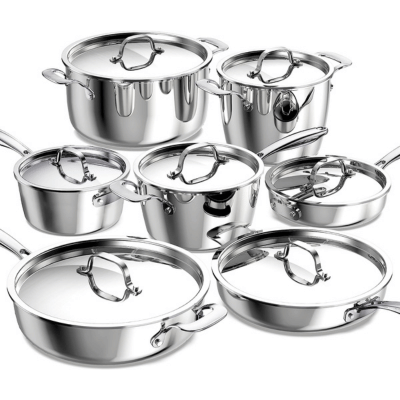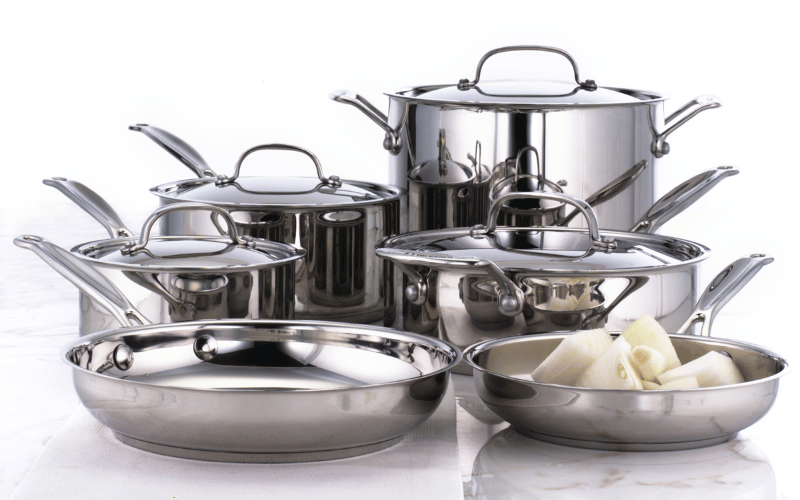18 8 vs 18 10 Stainless Steel Cookware: Which Grade is Worth It?
Stainless steel cookware has become a staple in modern kitchens due to its durability, versatility, and sleek appearance. Composed primarily of iron, chromium, and other elements, stainless steel is renowned for its resistance to corrosion, heat, and staining. Its non-reactive nature makes it ideal for cooking a wide range of foods, including acidic dishes. With its ability to distribute heat evenly and withstand high temperatures, stainless steel cookware offers efficient and reliable cooking performance. However, not all stainless steel is created equal, which brings us to the importance of selecting the right stainless steel grade.
Table of Contents
Choosing the right stainless steel grade for your cookware is essential as it can significantly impact your cooking experience and the longevity of your investment. Different stainless steel grades are distinguished by their composition, with variations in the proportions of chromium, nickel, and other elements. The specific grade of stainless steel used in cookware can affect its heat conductivity, corrosion resistance, durability, and even food safety. Understanding the differences between stainless steel grades, such as 18/8 and 18/10, allows you to make an informed decision and select the grade that best suits your cooking needs, preferences, and budget. Here we go!
Understanding Stainless Steel Grades
Stainless steel is graded based on its composition, which consists of various metals and elements. The most common grading system for stainless steel cookware uses a combination of numbers, such as 18/8 or 18/10, to represent the percentages of chromium and nickel in the alloy. The first number represents the percentage of chromium, which provides resistance to corrosion. In contrast, the second number represents the percentage of nickel, which enhances the overall durability and shine of the stainless steel.
18/8 stainless steel, also known as 304 stainless steel, is a popular grade for cookware. It contains 18% chromium and 8% nickel. This composition gives it excellent corrosion resistance, making it suitable for prolonged exposure to various cooking ingredients and cleaning agents. 18/8 stainless steel is also known for its high durability, making it resistant to dents and scratches. It has good heat conductivity, allowing for even heat distribution during cooking. Moreover, 18/8 stainless steel is non-reactive, ensuring that it does not interact with acidic or alkaline foods, preserving their flavors and preventing metallic taste.
18/10 stainless steel, also referred to as 316 stainless steel, is considered a premium grade for cookware. It consists of 18% chromium and 10% nickel. This higher nickel content enhances its corrosion resistance and provides superior resistance to pitting and crevice corrosion. 18/10 stainless steel is exceptionally durable, making it highly resistant to wear and tear. It also offers excellent heat conductivity, facilitating efficient cooking and minimizing hot spots. Like 18/8 stainless steel, 18/10 is non-reactive, ensuring that it does not alter the taste or quality of the food being prepared.


Heat Conductivity and Distribution
When comparing the heat conductivity of 18/8 and 18/10 stainless steel, both grades exhibit similar thermal properties. Due to their high chromium content, they have relatively low thermal conductivity compared to other metals like copper or aluminum.
Heat conductivity plays a crucial role in cooking performance. Stainless steel cookware with efficient heat conductivity allows for precise temperature control and reduces the risk of food sticking or burning. While 18/8 and 18/10 stainless steel may not match the heat conductivity of materials like copper, they still offer sufficient heat distribution for most cooking tasks, making them reliable choices for a variety of recipes.
Corrosion Resistance and Durability
18/8 stainless steel demonstrates excellent corrosion resistance due to its 18% chromium content. This chromium forms a protective layer on the surface, known as a passive film, which prevents rust and corrosion from developing. It is highly resistant to common corrosive agents found in kitchens, such as acidic foods and cleaning solutions.
With a higher nickel content of 10%, 18/10 stainless steel exhibits even greater corrosion resistance compared to 18/8. The additional nickel enhances its ability to withstand exposure to harsh environments, such as saltwater or acidic ingredients, making it an excellent choice for coastal areas or professional kitchens.
Both 18/8 and 18/10 stainless steel grades offer impressive durability. They resist dents, scratches, and wear, ensuring longevity and maintaining their appearance over time.
Food Safety and Reactivity
Food safety is a critical factor to consider when selecting stainless steel cookware. Stainless steel is generally regarded as safe for cooking, as it is non-reactive and does not leach harmful chemicals into food. This makes it an ideal choice for preparing a wide range of ingredients, including acidic or alkaline foods.
18/8 stainless steel exhibits minimal reactivity with food. It is highly stable and does not impart any metallic flavors or alter the taste of the food. The non-reactive nature of 18/8 stainless steel ensures that the flavors and nutritional integrity of the ingredients remain intact.
Similarly, 18/10 stainless steel showcases excellent non-reactivity. The higher nickel content in this grade further enhances its resistance to reactivity with food. It maintains the purity of flavors and does not introduce any unwanted taste or odor during the cooking process.
So, both 18/8 and 18/10 stainless steel grades provide a safe and reliable cooking surface, ensuring that your meals are prepared with the highest standards of food safety.
Maintenance and Care
To maintain 18/8 stainless steel cookware, it is recommended to wash it with warm soapy water and a non-abrasive sponge. Avoid using harsh cleaners or abrasive materials that can scratch the surface.
For 18/10 stainless steel cookware, similar cleaning practices apply. Use mild dish soap and warm water to clean the cookware. Avoid using abrasive cleaners or scrubbers that can damage the surface.
Regularly polish the cookware to maintain its lustrous appearance. Additionally, it is advisable to dry the stainless steel cookware thoroughly after washing to prevent water spots or mineral deposits.
Price and Value
When comparing prices, 18/8 stainless steel cookware tends to be more affordable compared to 18/10 stainless steel cookware. The difference in price is primarily due to the higher nickel content in 18/10 stainless steel, which adds to its corrosion resistance and durability.
The value for money in choosing between 18/8 and 18/10 stainless steel cookware depends on individual preferences and priorities. While 18/10 stainless steel offers superior corrosion resistance and longevity, 18/8 stainless steel still provides excellent performance at a more budget-friendly price point. Ultimately, the decision should be based on personal needs, desired features, and budget considerations.
Choosing the Right Grade for Your Needs
When selecting a stainless steel grade, consider factors such as corrosion resistance, durability, heat conductivity, and reactivity. Assessing these properties will help determine which grade aligns with your requirements. Identify your cooking preferences and priorities. If you frequently cook acidic or alkaline dishes, prioritize a grade with high corrosion resistance. If even heat distribution is crucial, opt for a grade with good heat conductivity. Consider your desired durability, maintenance needs, and aesthetic preferences as well.
Based on specific needs, 18/10 stainless steel is recommended for those seeking maximum corrosion resistance and durability. However, if budget is a priority, 18/8 stainless steel offers a reliable option with good performance. Select the grade that best fits your needs and provides the desired balance of properties within your budget.
In conclusion, the key differences between 18/8 and 18/10 stainless steel cookware lie in their composition, corrosion resistance, and price. While both grades offer excellent durability and non-reactivity, 18/10 stainless steel provides superior corrosion resistance due to its higher nickel content. However, 18/8 stainless steel remains a cost-effective option without compromising on performance. The choice between the two grades ultimately depends on individual needs and priorities, such as budget, cooking preferences, and desired levels of corrosion resistance.

Hey There, I’m Monica, Mom of two. This is my personal blog site. Here I write about Kitchen Tips Tricks, Recipes, and Review the products I use.
I hope you enjoy the article. Give me feedback on how I’m doing with my blog. I would appreciate it so much.
Have a great day! 🙂
[Follow me on Twitter]



